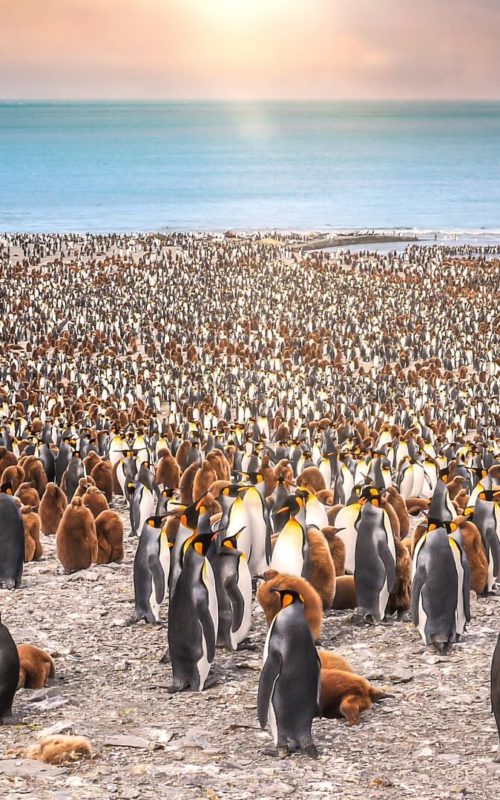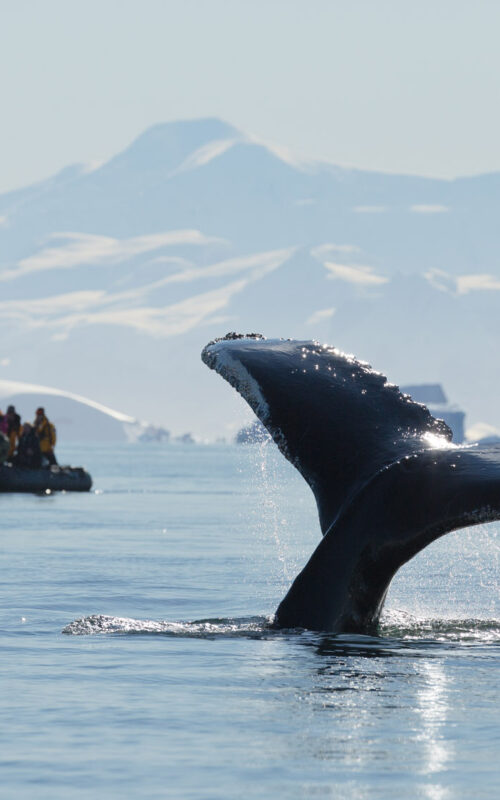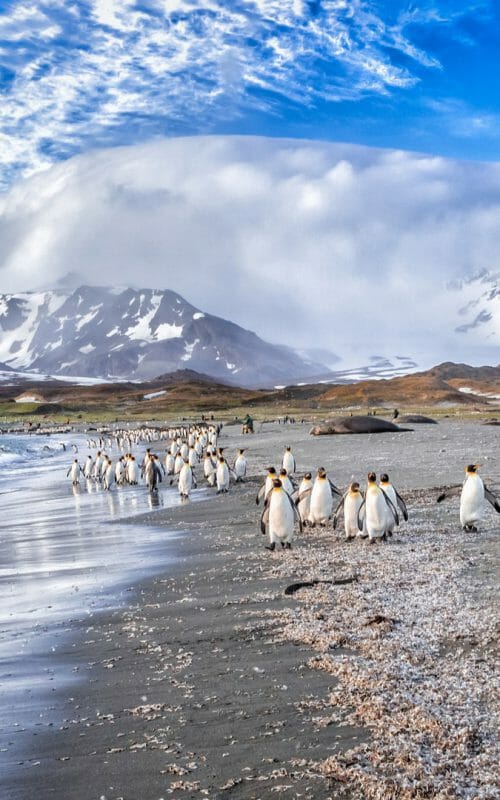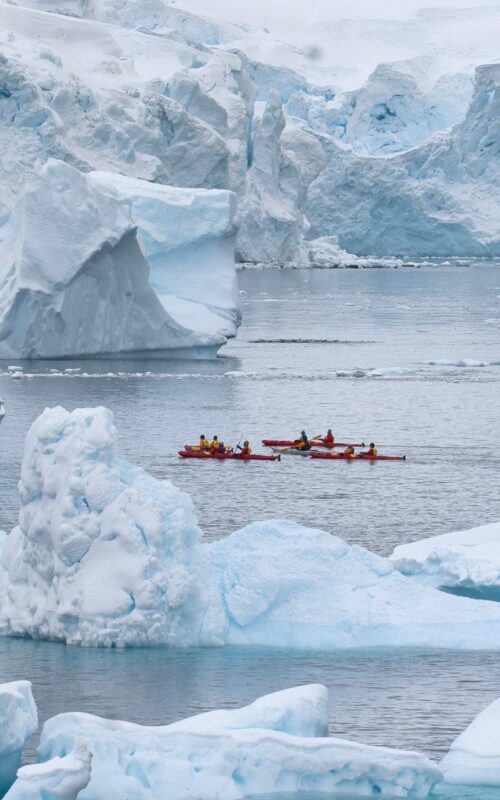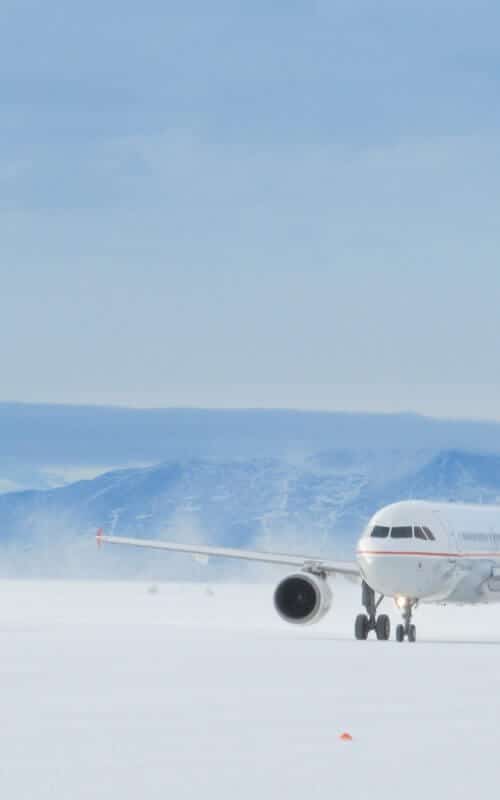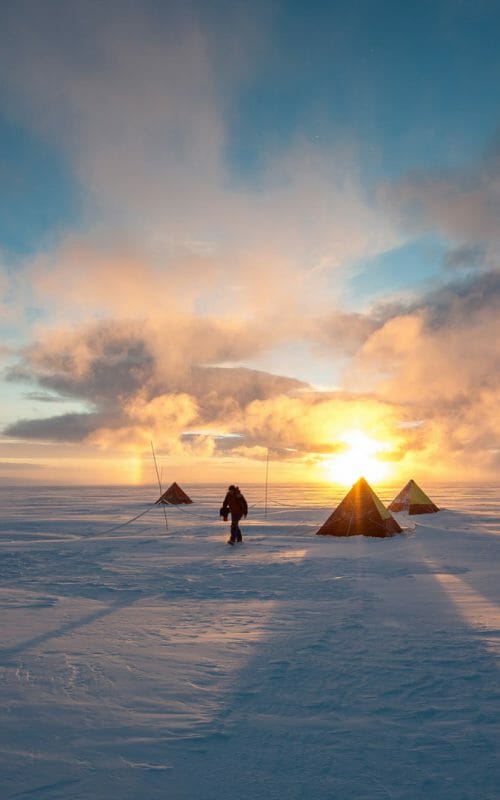As would be expected of the world’s southernmost continent, Antarctica maintains a harsh climate year-round. In the coldest, highest and windiest continent on the planet there are just two seasons, summer and winter. It is only possible to travel to Antarctica during its summer months between late October to early April, a time when wildlife is active and the sun almost never sets (a spectacle known as the Midnight Sun).
The summer season is further defined by the early season, the peak season and the late season. Choosing when to travel depends on what you wish to get out of your voyage, as each of the three phases have their own unique advantages. It is important to remember that no matter when you travel to Antarctica, it is always astonishing!
In the severe winter months between April and September, conditions are too treacherous for commercial travel – although small teams of scientists that range from temperature-tracking climatologists to universe-seeking astronomers do brave the long, cold Antarctic night. During winter, the continent is plunged into absolute darkness and temperatures hit hostile lows of -60ºC. Antarctica is the coldest place on Earth (colder than both the Arctic and the summit of Mount Everest).
The Early Season: “The Pristine Season”
(late October and November)
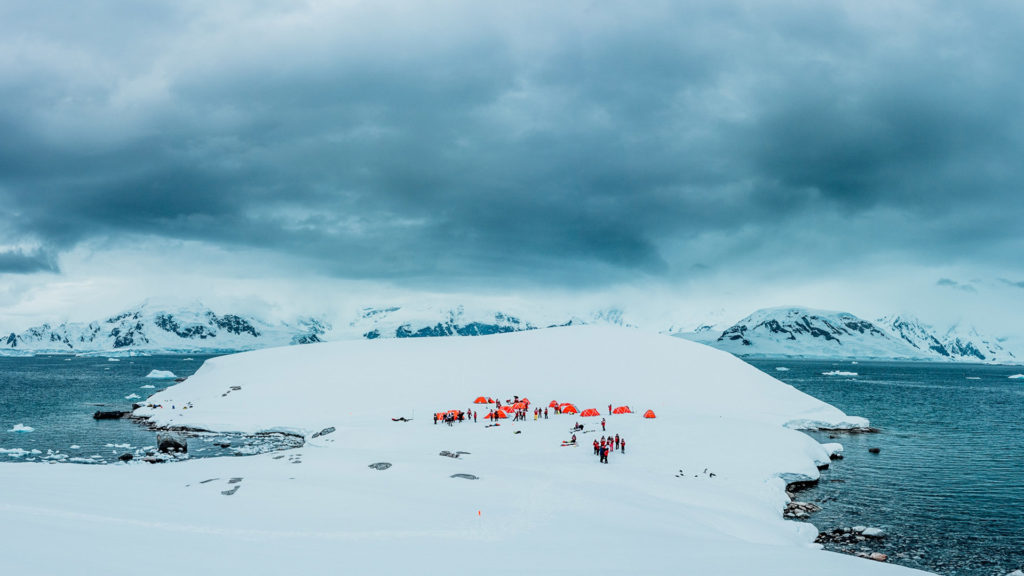
- Pristinely white with lots of sea ice and the possibility of snowfall
- Less vessels and people, making for a more expeditionary experience
- Adelie penguins lay their eggs and king penguins waddle around while incubating theirs
- Expeditions to find emperor penguins begin on icebreakers and inland camping trips
Late October and November fall into the early season, which also happens to be the coldest and most pristine summer season. Special discounted rates may be offered during this time. Skies are generally overcast with gradually decreasing cloud cover, and conditions are optimal for extremely photogenic snowfall. This coupled with the blankets of thick, fresh snow from the winter season and the absence of human footprints makes the early season a photographers’ dream.
This is the only time to see imposing sea ice before it breaks up in the peak season. It is the most unpredictable season in terms of weather, and there is a little less wildlife activity than during the peak time, but these conditions make for a more isolated and expeditionary feeling as there are fewer vessels. The landing strip on King George Island opens during this time, meaning air-cruising is possible and people start arriving for inland camping expeditions to emperor penguin hotspots.
On the wildlife front, sea birds (including petrels, albatrosses and skuas) and penguins (including gentoos, Adelies and chinstraps) begin their courtship and nesting rituals. You might even find the elusive emperor penguins if travelling on an icebreaker to Snow Hill in the Weddell Sea. In November, female king penguins waddle around with their new eggs balanced on their feet and fur seals turn rather aggressive as they go through their peak mating time. Meanwhile, the Falkland Islands are abundant with spring flowers and elephant seals are courting (and beachmasters are fighting) on South Georgia Island.
The temperatures in Antarctica are difficult to estimate, especially since wind chill can drastically alter the ‘feel like’ temperature – but during the early season, prepare for temperatures of -8ºC to 2ºC (but as low as -20ºC inland).
Talk to an expert about the early season
The Peak Season: “The Penguin Chick Season”
(December to mid-February)
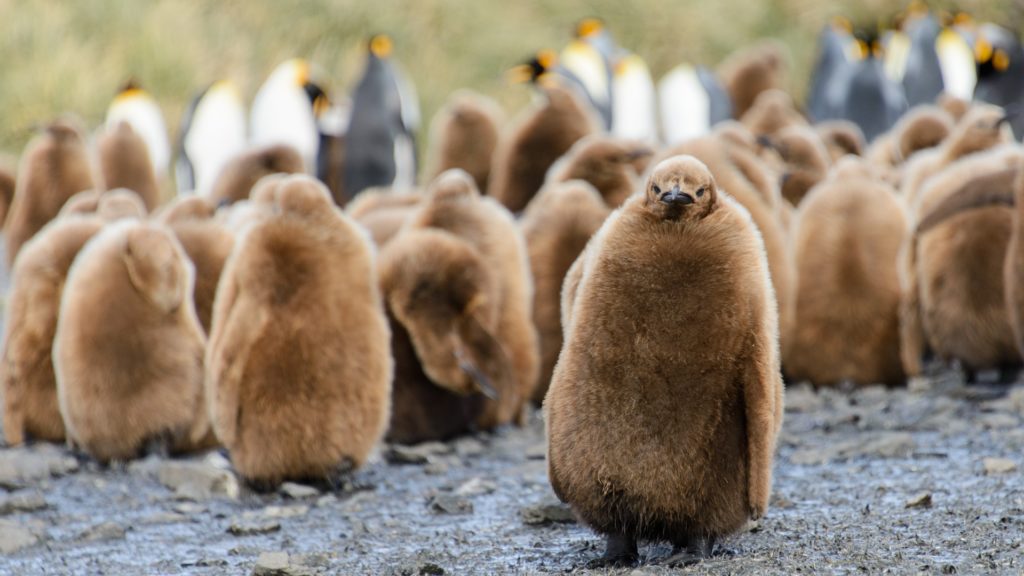
- Penguin rookeries are full of fluffy newborn chicks
- Sailings to the Antarctic Circle and Shackleton & Scott’s huts begin as the sea ice recedes
- Baleen and toothed whales arrive to feed and seals lounge on ice floes
- Iconic feeding rituals begin as penguins are chased along the beaches by their hungry chicks
December and January fall into the peak season, which also happens to be the warmest summer season with between 18 and 24 hours of sunlight. Antarctica is never crowded, but this is generally the most popular time when most people visit the continent. While most of the sea ice has receded and many of the iconic ice formations have disappeared, this is the time during which it is possible to see and hear colossal glaciers calving. As the wildlife populations are abundant and penguin rookeries are at full capacity, visitors flock to come face-to-face with inquisitive newborn chicks.
Skies are generally sunny, meaning snowfall is unlikely, and some ground snow on the Peninsula melts to reveal grey rocks underneath. Typically, snowshoeing is possible up until Christmas, but thereafter the sport becomes unfeasible. Lesser amounts of snow and increase in glare means that the peak season is not a favourite with most landscape photographers, however it is the perfect time for wildlife photographers to capture portraits of highly photogenic, fluffy penguin chicks. Shifting ice conditions during this time make it possible for specialist voyages to cross the coveted Antarctic Circle and to access the historic huts of Shackleton & Scott.
On the wildlife front, the Peninsula comes alive as several species of both baleen and toothed whales arrive from tropical climes and penguin chicks begin hatching. In January comes one of Antarctica’s most staggering sightings as adult penguins come ashore to feed (and be chased by) their thousands-strong population of ravenous young. You might even have close encounters with ice-floe-lounging crabeater, leopard and Weddell seals while kayaking. Meanwhile, penguin chicks are hatching on the Falkland Islands in early December and seal pups cover the beaches of South Georgia Island.
The temperatures in Antarctica are difficult to estimate, especially since wind chill can drastically alter the ‘feel like’ temperature – but during the peak season, prepare for temperatures of -2ºC to 5ºC (but as low as -20ºC inland).
Talk to an expert about the peak season
The Late Season: “The Whale Season”
(Mid-February to early April)
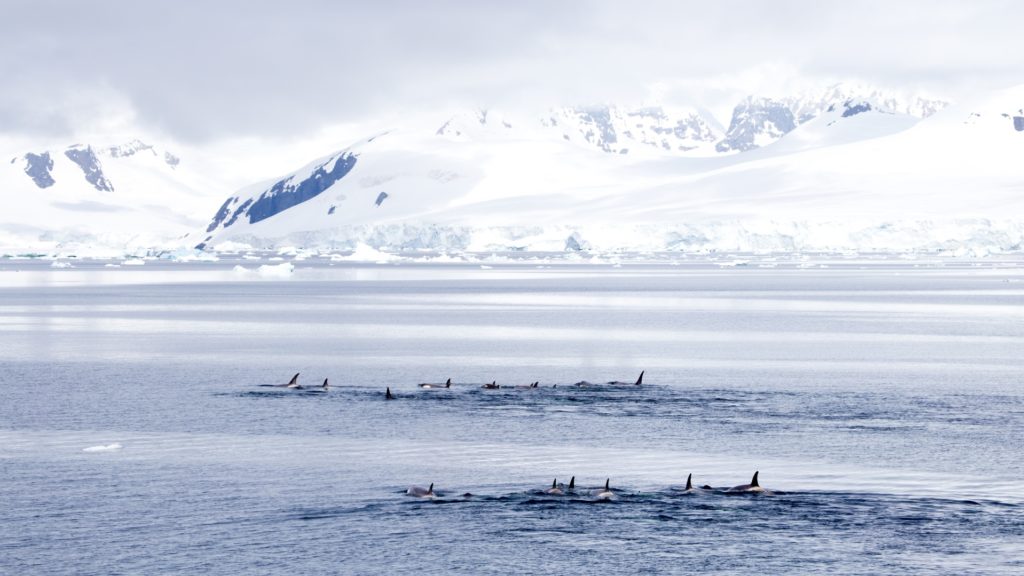
- Whales fill the waters and juvenile humpbacks are particularly inquisitive with visitors
- Less pristinely white but more expeditionary in feeling as there are fewer vessels and people
- Penguin chicks begin to moult their fluffy feathers and search for their own food
- Low sun creates marvellous sunrises and sunsets
February and March fall into the late season, just before the long winter returns and the continent is plunged into 24-hour darkness! Special discounted rates may be offered during this time. Since the sea ice has receded to its greatest extent and much of the iconic ice formations have disappeared, this is perhaps not the ideal season for those who dream of seeing Antarctica pristinely white and covered in snow. There are fewer visitors in the late season – but with less vessels in the water and fewer people on shore, those who visit during this time have a more isolated and expeditionary experience.
Skies are generally overcast with gradually increasing cloud cover, and the falling temperatures mean photogenic snowfall is possible towards the end of the season. The absence of fresh ground snow coupled with the slightly dishevelled look of the moulting penguin chicks (still adorable in our opinion!) means that the late season is not a favourite with most wildlife photographers, however the low sun does make it an optimal time to capture magnificent sunrises and sunsets. The minimal ice conditions also make this an excellent time to join a sailing across the coveted Antarctic Circle and to travel to more remote locations that were inaccessible in the early and peak season.
On the wildlife front, penguin colonies become smaller throughout February and into early March – although there are still thousands – and the chicks are taking to the waters for the first time on independent crusades for food. With so many young and inexperienced chicks in the water, predators like leopard seals and orcas patrol in search of an easy meal.
Towards the middle of March, most of the wildlife starts departing for the open sea where they spend the polar winter. An enormous numbers of marine mammals feed in the cold waters before migrating north to their breeding grounds, so this is the ideal time to travel for whale-watchers. What’s more, juvenile humpbacks become particularly inquisitive and this can make for some unforgettable sightings. This is an outstanding time to visit South Georgia Island because of the huge populations of king penguins, playful fur seals and wandering albatross chicks.
The temperatures in Antarctica are difficult to estimate, especially since wind chill can drastically alter the ‘feel like’ temperature – but during the late season, prepare for temperatures of -6ºC to 4ºC (but as low as -20ºC inland).

